Crystal Plasticity Modeling and Experimental Validation with an Orientation Distribution Function for Ti-7Al Alloy
Abstract
:1. Introduction
2. Multi-Scale Modeling of Microstructures
3. Optimization for Slip System Parameters Identification of Ti-Al Alloys
3.1. Optimization of Slip System Parameters for Ti-0Al
3.2. Optimization of Slip System Parameters for Ti-7Al
3.3. CPFE Analysis for Ti-7Al
4. Conclusions
Acknowledgments
Author Contributions
Conflicts of Interest
References
- Allison, J.; Backman, D.; Christodoulou, L. Integrated Computational Materials Engineering: A New Paradigm for the Global Materials Profession. J. Miner. Met. Mater. Soc. 2006, 58, 25–27. [Google Scholar] [CrossRef]
- Taylor, G. Plastic strain in metals. J. Inst. Met. 1938, 62, 307–324. [Google Scholar]
- Asaro, R.J.; Needleman, A. Texture development and strain hardening in rate dependent polycrystals. Acta Metall. 1985, 33, 923–953. [Google Scholar] [CrossRef]
- Canova, G.R.; Kocks, U.F.; Jonas, J.J. Theory of torsion texture development. Acta Metall. 1984, 32, 211–226. [Google Scholar] [CrossRef]
- Molinari, A.; Canova, G.R.; Ahzi, S. A self consistent approach of the large deformation polycrystal viscoplasticity. Acta Metall. 1987, 35, 2983–2994. [Google Scholar] [CrossRef]
- Tiem, S.; Berveiller, M.; Canova, G.R. Grain shape effects on the slip system activity and on the lattice rotations. Acta Metall. 1986, 34, 2139–2149. [Google Scholar] [CrossRef]
- Acar, P.; Sundararaghavan, V. Uncertainty Quantification of Microstructural Properties due to Variability in Measured Pole Figures. Acta Metall. 2017, 124, 100–108. [Google Scholar] [CrossRef]
- Acar, P.; Sundararaghavan, V. Utilization of a Linear Solver for Multiscale Design and Optimization of Microstructures in an Airframe Panel Buckling Problem. In Proceedings of the 57th AIAA/ASCE/AHS/ASC Structures, Structural Dynamics, and Materials Conference, San Diego, CA, USA, 4–8 January 2016. [Google Scholar]
- Acar, P.; Sundararaghavan, V. Uncertainty Quantification of Microstructural Properties due to Experimental Variations. AIAA J. 2017, 55, 2824–2832. [Google Scholar] [CrossRef]
- Sundararaghavan, V.; Zabaras, N. On the synergy between texture classification and deformation process sequence selection for the control of texture-dependent properties. Acta Metall. 2005, 53, 1015–1027. [Google Scholar] [CrossRef]
- Adams, B.L.; Henrie, A.; Henrie, B.; Lyon, M.; Kalidindi, S.R.; Garmestani, H. Microstructure-Sensitive Design of a Compliant Beam. J. Mech. Phys. Solids 2001, 49, 1639–1663. [Google Scholar] [CrossRef]
- Kalidindi, S.R.; Houskamp, J.; Lyons, M.; Adams, B.L. Microstructure Sensitive Design of an Orthotropic Plate Subjected to Tensile Load. Int. J. Plast. 2004, 20, 1561–1575. [Google Scholar] [CrossRef]
- Fast, T.; Knezevic, M.; Kalidindi, S.R. Application of microstructure sensitive design to structural components produced from hexagonal polycrystalline metals. Comput. Mater. Sci. 2008, 43, 374–383. [Google Scholar] [CrossRef]
- Liu, R.; Kumar, A.; Chen, Z.; Agrawal, A.; Sundararaghavan, V.; Choudhary, A. A predictive machine learning approach for microstructure optimization and materials design. Nat. Sci. Rep. 2015, 5, 11551. [Google Scholar] [CrossRef] [PubMed]
- Sarma, G.B.; Dawson, P.R. Effects of interactions among crystals on the inhomogeneous deformations of polycrystals. Acta Mater. 1996, 44, 1937–1953. [Google Scholar] [CrossRef]
- Raabe, D.; Roters, F. Using texture components in crystal plasticity finite element simulations. Int. J. Plast. 2004, 20, 339–361. [Google Scholar] [CrossRef]
- Matthies, S.; Wenk, H.-R.; Vinel, G.W. Some basic concepts of texture analysis and comparison of three methods to calculate orientation distributions from pole figures. J. Appl. Cryst. 1988, 21, 285–304. [Google Scholar] [CrossRef]
- Dawson, P.R.; Marin, E.B. Computational Mechanics for Metal Deformation Processes Using Polycrystal Plasticity. Adv. Appl. Mech. 1997, 34, 77–169. [Google Scholar]
- Zheng, Q.S.; Zou, W.N. Orientation distribution functions for microstructures of heterogeneous materials (I)—Directional distribution functions and irreducible tensors. Appl. Math. Mech. 2001, 22, 865–884. [Google Scholar] [CrossRef]
- Pospiech, J.; Lucke, K.; Sztwiertnia, K. Orientation Distribution and Orientation Correlation Functions for Description of Microstructures. Acta Metall. Mater. 1993, 41, 305–321. [Google Scholar] [CrossRef]
- Bunge, H.J. Texture Analysis in Materials Science; Butterworths: London, UK, 1982. [Google Scholar]
- Kocks, U.F.; Tome, C.N.; Wenk, H.R. Texture and Anisotropy; Cambridge University Press: Cambridge, UK, 2000. [Google Scholar]
- Heinz, A.; Neumann, P. Representation of Orientation and Disorientation Data for Cubic, Hexagonal, Tetragonal and Orthorhombic Crystals. Acta Crystallogr. 1991, A47, 780–789. [Google Scholar] [CrossRef]
- Kumar, A.; Dawson, P.R. Computational Modeling of F.C.C. Deformation Textures over Rodrigues’ Space. Acta Mater. 2000, 48, 2719–2736. [Google Scholar] [CrossRef]
- Kumar, A.; Dawson, P.R. Modeling Crystallographic Texture Evolution with Finite Elements over Neo-Eulerian Orientation Spaces. Comput. Methods Appl. Mech. Eng. 2000, 153, 259–302. [Google Scholar] [CrossRef]
- Nervo, L.; King, A.; Fitzner, A.; Ludwig, W.; Preuss, M. A study of deformation twinning in a titanium alloy by X-ray diffraction contrast tomography. Acta Mater. 2016, 105, 417–428. [Google Scholar] [CrossRef]
- Balasubramanian, S. Application to Deformation Processing of Lightweight Metals. Ph.D. Dissertation, Massachusetts Institute of Technology, Cambridge, MA, USA, February 1998. [Google Scholar]
- Williams, J.C.; Baggerly, R.G.; Paton, N.E. Deformation Behavior of HCP Ti-Al Alloy Single Crystals. Metall. Mater. Trans. A 2002, 33, 837. [Google Scholar] [CrossRef]
- Lienert, U.; Brandes, M.C.; Bernier, J.V.; Weiss, J.; Shastri, S.V.; Mills, M.J.; Miller, M.P. In-situ single-grain peak profile measurements on Ti-7 Al during tensile deformation. Mater. Sci. Eng. A 2009, 524, 46–54. [Google Scholar] [CrossRef]
- Lutjering, G.; Williams, J. Introduction. In Titanium, 2nd ed.; Springer: Berlin, Germany, 2007. [Google Scholar]
- Khan, A.S.; Kazmia, R.; Farrokha, B.; Zupana, M. Effect of oxygen content and microstructure on the thermo-mechanical response of three Ti–6Al–4V alloys: Experiments and modeling over a wide range of strain-rates and temperatures. Int. J. Plast. 2007, 23, 1105–1125. [Google Scholar] [CrossRef]
- Fitzner, A.G. Effects of Alloying Elements on Twinning in Alpha-Titanium Alloys. Ph.D. Dissertation, University of Manchester, Manchester, UK, 2014; p. 261. [Google Scholar]
- Fitzner, A.G.; Prakash, D.G.L.; Fonseca, J.Q.; Thomas, M.; Zhang, S.; Kelleher, J.; Manuel, P.; Preuss, M. The effect of aluminum on twinning in binary alpha-Titanium. Acta Mater. 2016, 103, 341–351. [Google Scholar] [CrossRef]
- Acar, P.; Sundararaghavan, V. Utilization of a Linear Solver for Multiscale Design and Optimization of Microstructures. AIAA J. 2016, 54, 1751–1759. [Google Scholar] [CrossRef]
- Anand, L.; Kothari, M. A computational procedure for rate-independent crystal plasticity. J. Mech. Phys. Solids 1996, 44, 525–558. [Google Scholar] [CrossRef]
- Galan-Lopez, J.; Naghdy, S.; Verleysen, P.; Kestens, L.A.I.; Coghe, F.; Rabet, L.; Degrieck, J. Mechanical behavior and texture prediction of Ti-6Al-4V based on elastic viscoplastic self-consistent modelling. IOP Conf. Ser. Mater. Sci. Eng. 2015, 82, 012027. [Google Scholar] [CrossRef]
- Wu, Z.-H.; Kou, H.-C.; Tang, B.; Shao, J.; Han, F.-B.; Li, J.-S. Crystal Plasticity Finite-element Simulation of Ti-6Al-4V Alloy with 3D Polycrystalline Models. In Proceedings of the 2nd Annual International Conference on Advanced Material Engineering (AME 2016), Wuhan, China, 15–17 April 2016. [Google Scholar]
- Thomas, J.; Groeber, M.; Ghosh, S. Image-based crystal plasticity FE framework for microstructure dependent properties of Ti-6Al-4V alloys. Mater. Sci. Eng. A 2012, 553, 164–175. [Google Scholar] [CrossRef]
- Sundararaghavan, V.; Kumar, A. Probabilistic modeling of microstructure evolution using finite element representation of statistical correlation functions. Int. J. Plast. 2012, 30–31, 62–80. [Google Scholar] [CrossRef]
- Sundararaghavan, V.; Zabaras, N. A multi-length scale sensitivity analysis for the control of texture-dependent properties in deformation processing. Int. J. Plast. 2008, 24, 1581–1605. [Google Scholar] [CrossRef]
- Sha, W.; Malinov, S. Titanium Alloys: Modelling of Microstructure, Properties and Applications; Elsevier: Amsterdam, The Netherlands, 2009. [Google Scholar]
- Deb, K.; Pratap, A.; Agarwal, S.; Meyarivan, T. A Fast Elitist Multiobjective Genetic Algorithm: NSGA-II. IEEE Trans. Evol. Comput. 2002, 6, 182–197. [Google Scholar] [CrossRef]
- Rigoni, E.; Turco, A. Metamodels for fast Multi-Objective Optimization: Trading Off Global Exploration and Local Exploitation. In Proceedings of the SEAL 2010 LNCS, Kanpur, India, 1–4 December 2010; Volume 6457, pp. 523–532. [Google Scholar]
- Salem, A.A.; Kalidindi, S.R.; Semiatin, S.L. Strain hardening due to deformation twinning in α-titanium: Constitutive relations and crystal-plasticity modeling. Acta Mater. 2005, 53, 3495–3502. [Google Scholar] [CrossRef]
- McKay, M.D.; Beckman, R.J.; Conover, W.J. A comparison of three methods for selecting values of input variables in the analysis of output from a computer code. Technometrics 1979, 21, 239–245. [Google Scholar]
- Shahba, A.; Ghosh, S. Crystal plasticity FE modeling of Ti alloys for a range of strain-rates. Part I: A unified constitutive model and flow rule. Int. J. Plast. 2016, 87, 48–68. [Google Scholar] [CrossRef]
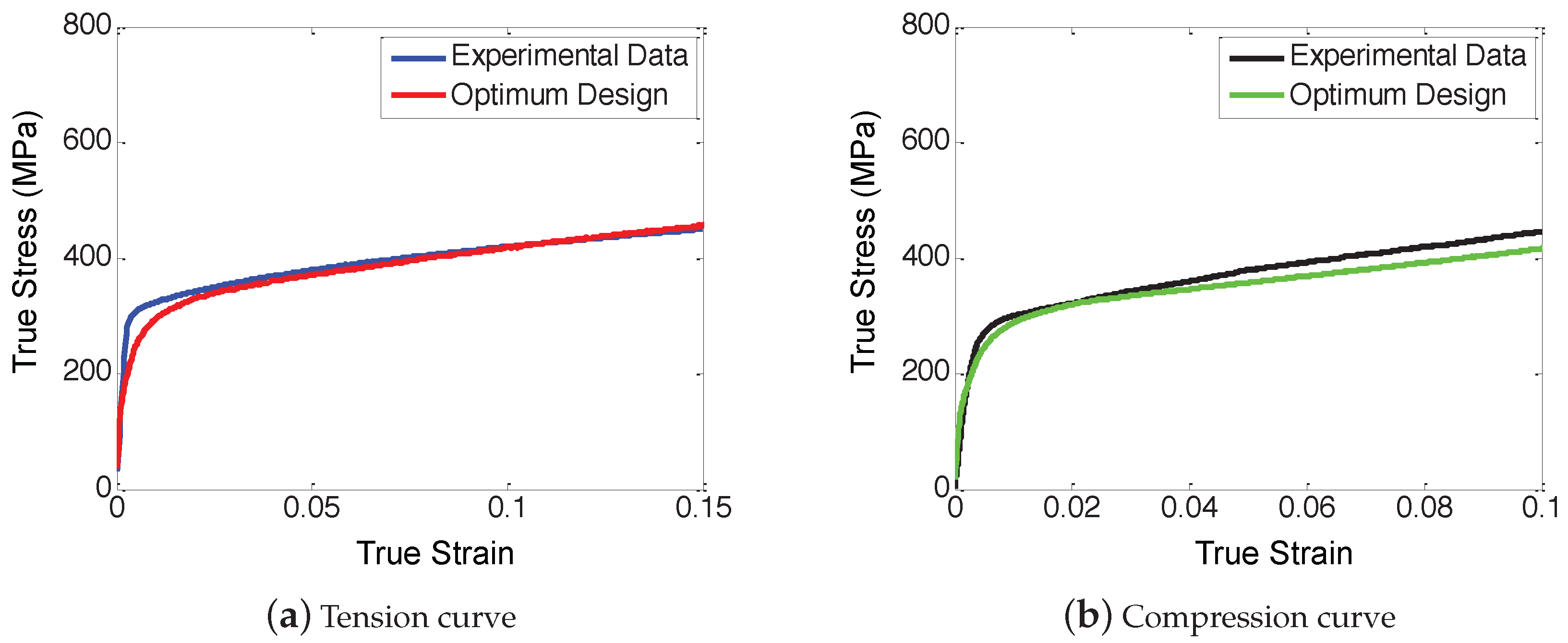
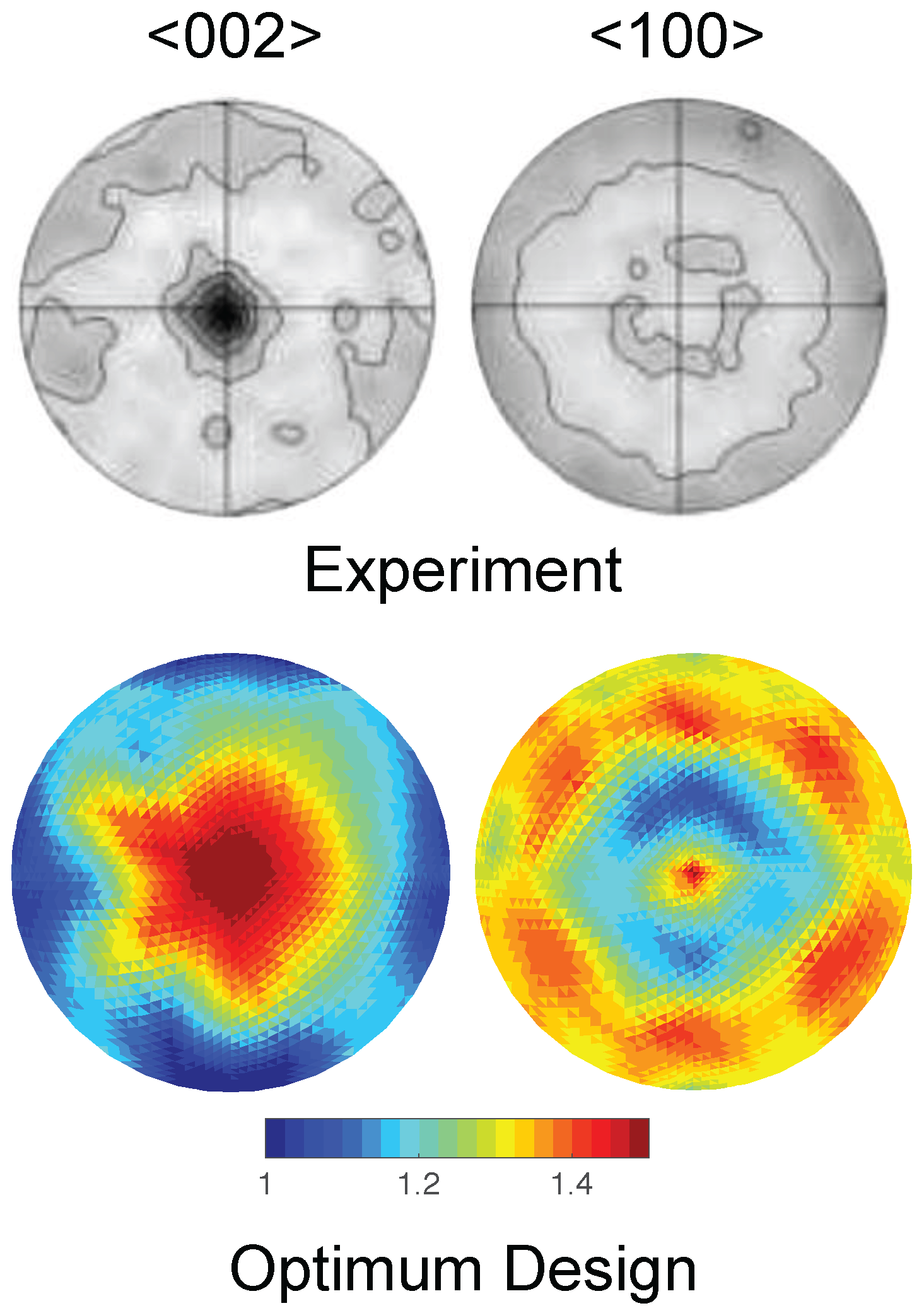
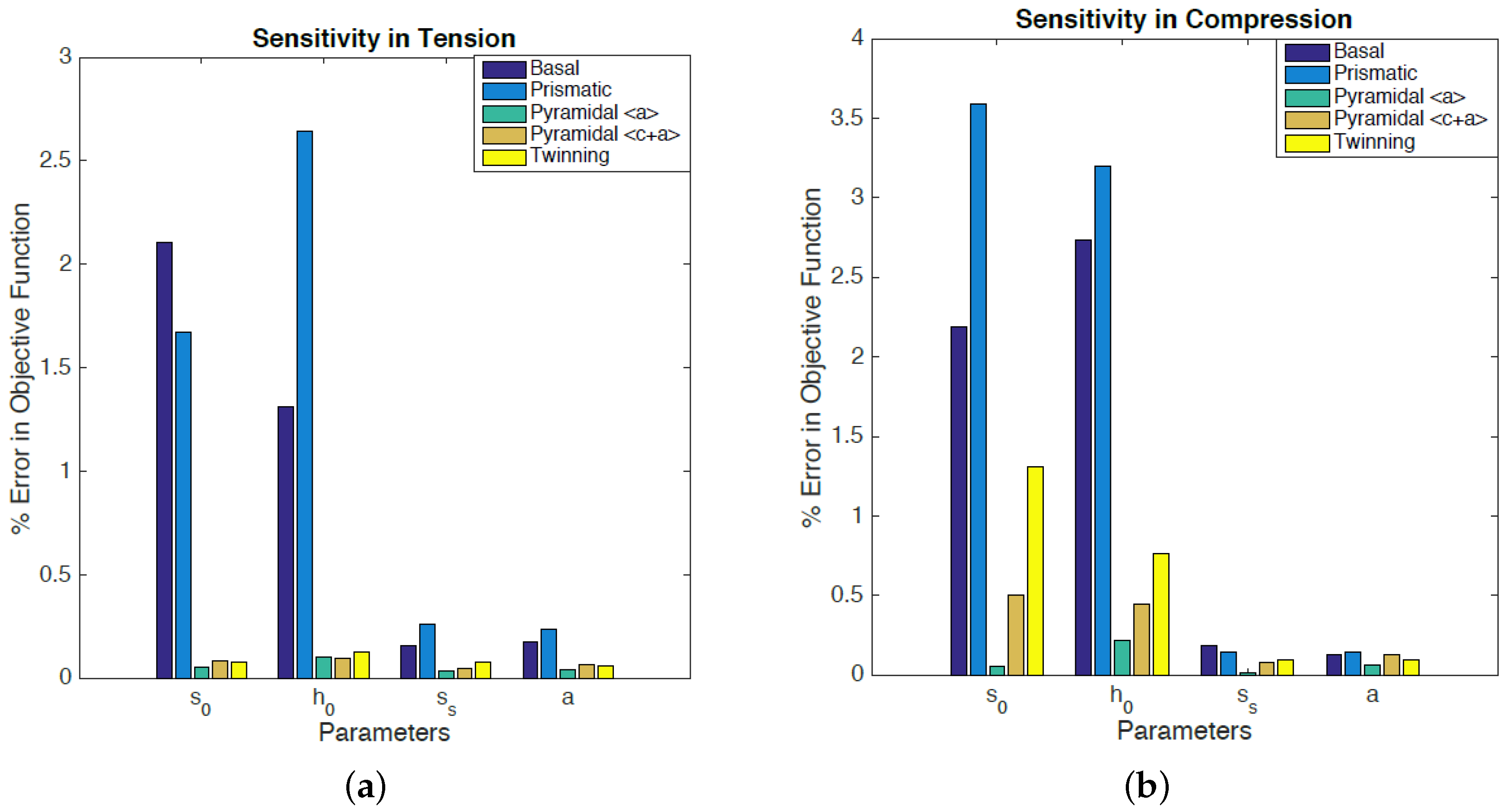
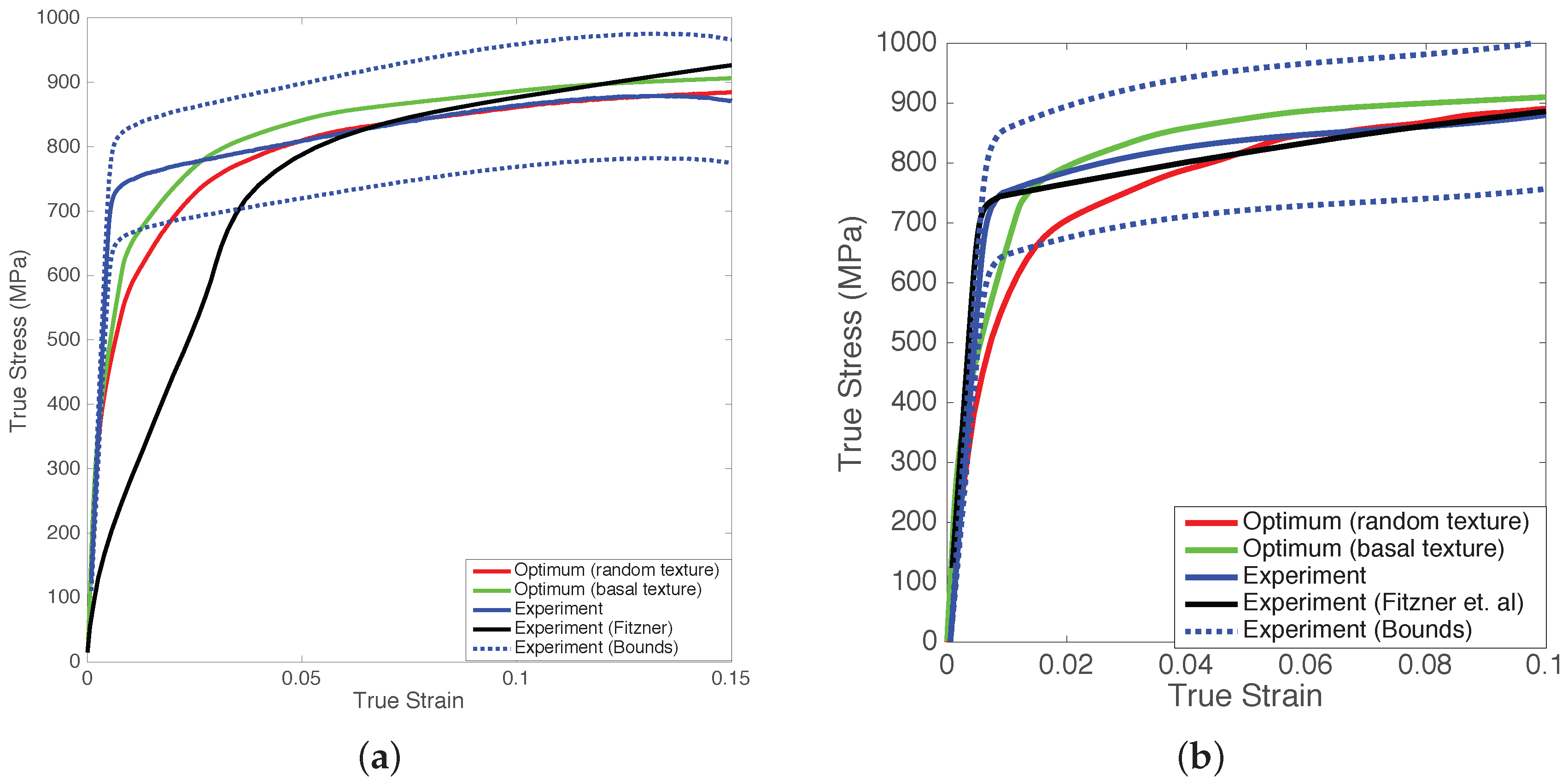
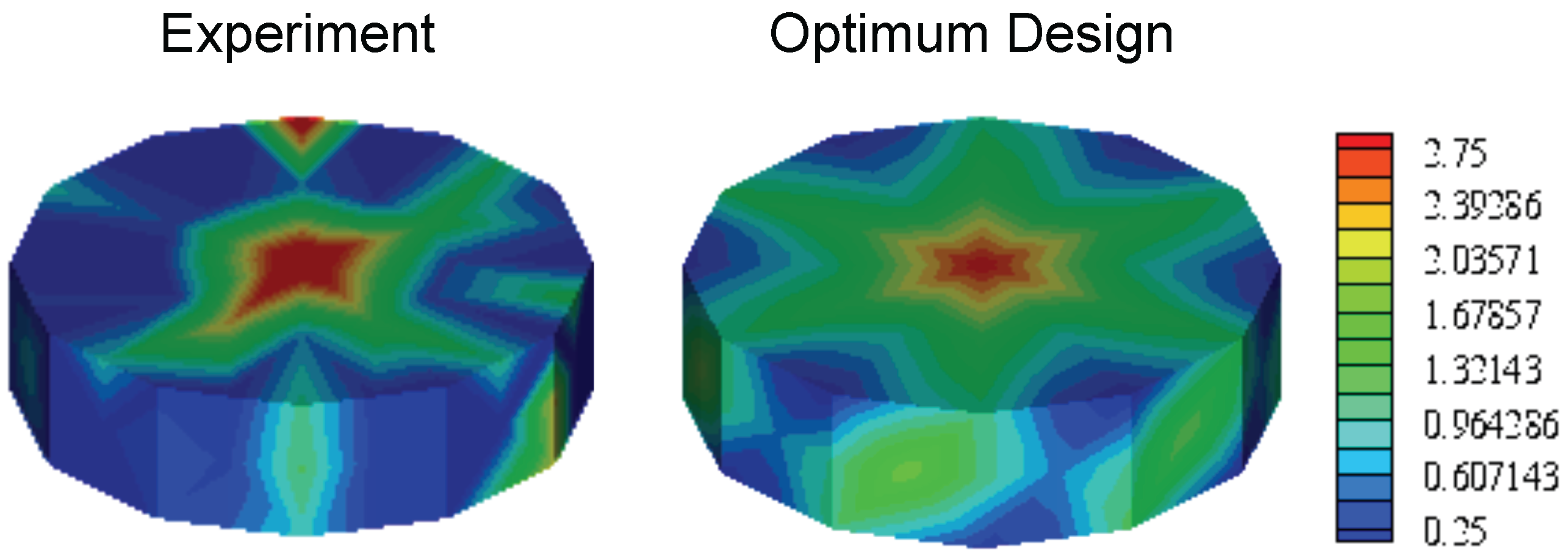
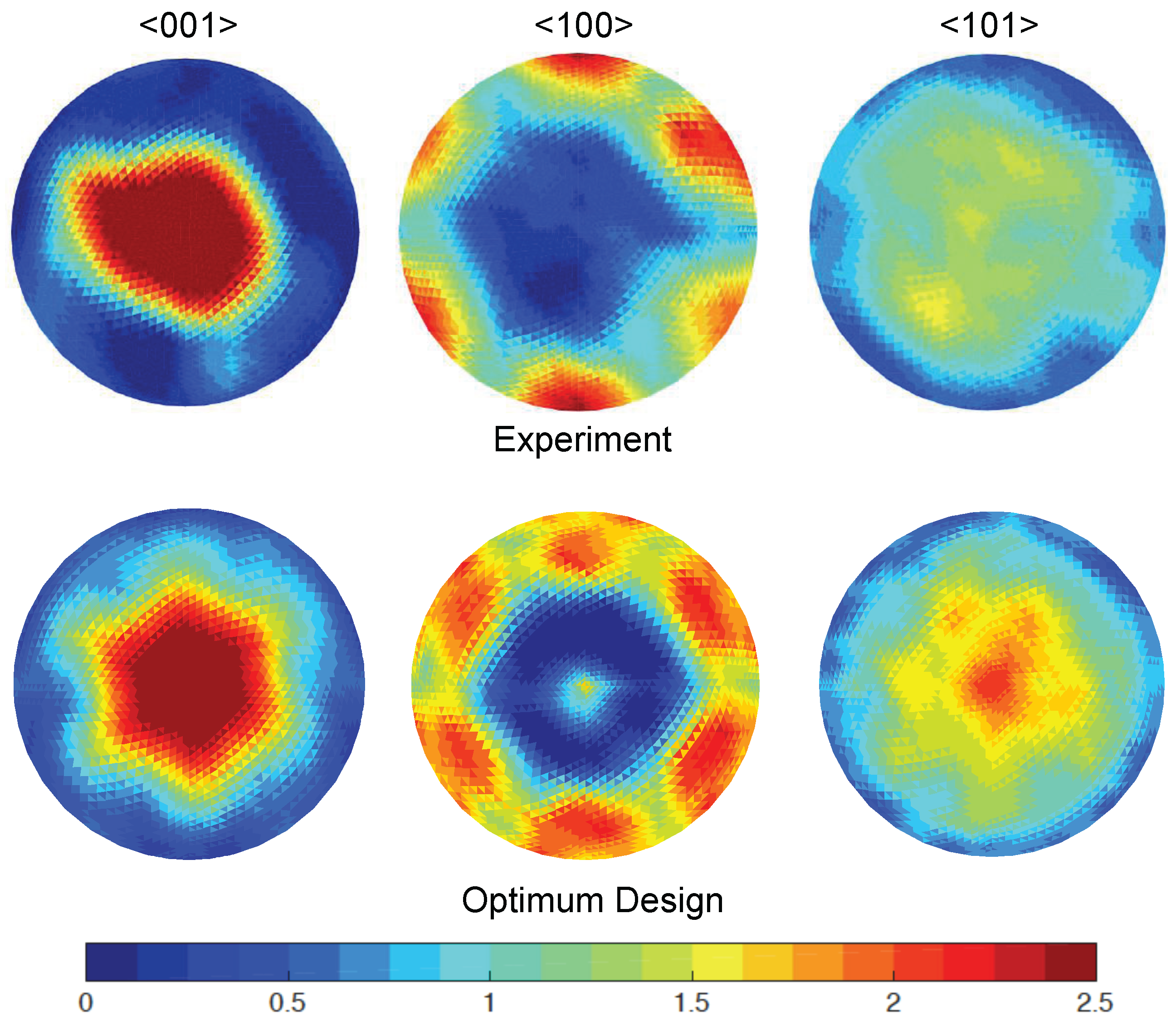
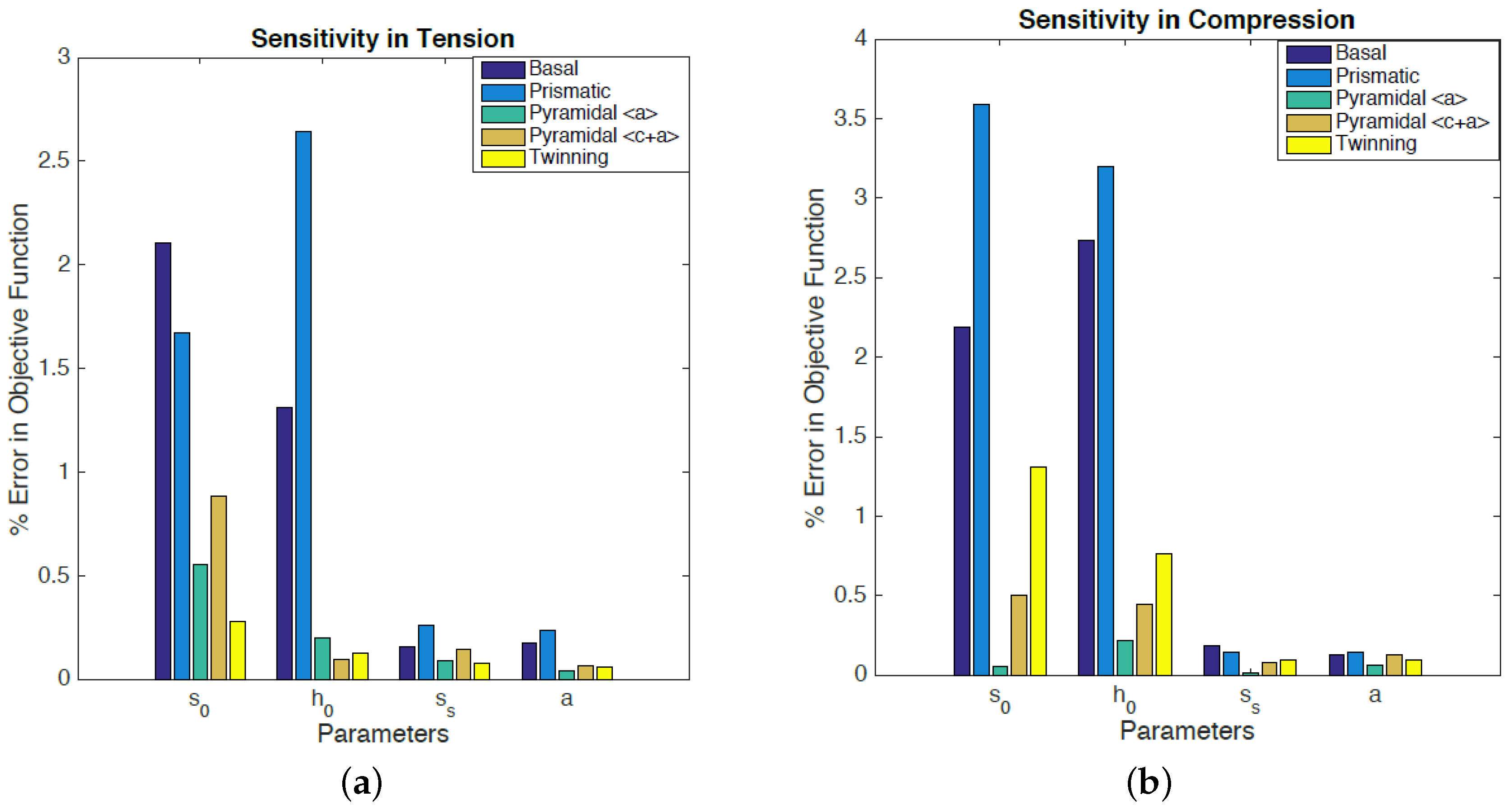
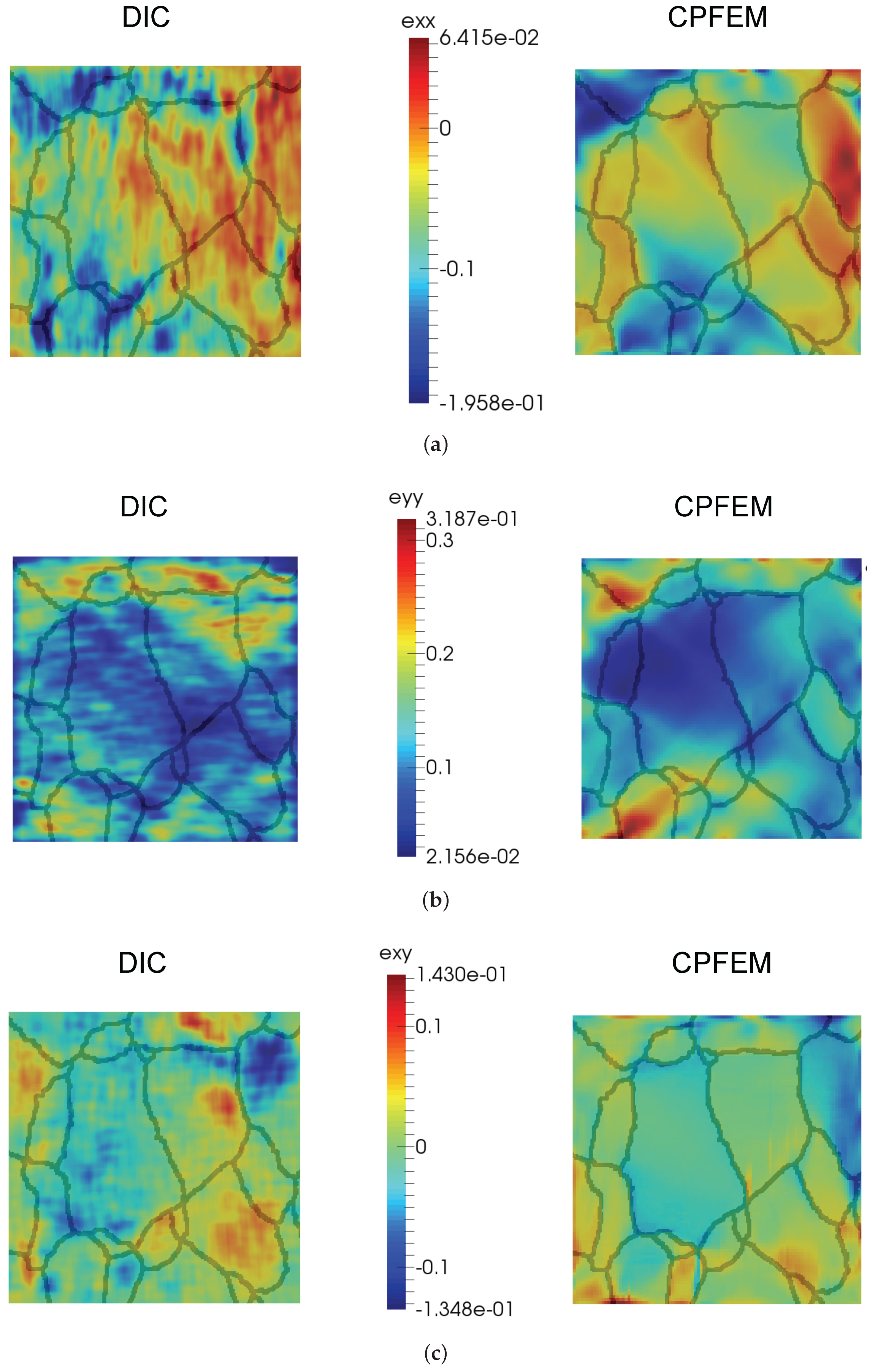
| Slip System | a | |||
|---|---|---|---|---|
| Basal | MPa | MPa | MPa | 0.25 |
| Prismatic | MPa | MPa | MPa | 0.25 |
| Pyramidal | MPa | MPa | MPa | 0.25 |
| Pyramidal | MPa | MPa | MPa | 0.25 |
| Twinning | MPa | MPa | MPa | 0.25 |
| Slip System | a | |||
|---|---|---|---|---|
| Basal | MPa | MPa | MPa | 1.38 |
| Prismatic | MPa | MPa | MPa | 1.38 |
| Pyramidal | MPa | MPa | MPa | 1.38 |
| Pyramidal | MPa | MPa | MPa | 1.38 |
| Twinning | MPa | MPa | MPa | 3.96 |
| Reference | () | () | |||
|---|---|---|---|---|---|
| Nervo et al. [26] | - | - | - | - | |
| Williams et al. [28] | ≈ | ≈ | - | - | - |
| Lutjering and Williams [30] | ∼200 MPa | ∼200 MPa | ∼800 MPa | - | - |
| Shahba and Ghosh [46] | 230 MPa | 205 MPa | 610 MPa | - | - |
| Present study | MPa | MPa | MPa | MPa | MPa |
© 2017 by the authors. Licensee MDPI, Basel, Switzerland. This article is an open access article distributed under the terms and conditions of the Creative Commons Attribution (CC BY) license (http://creativecommons.org/licenses/by/4.0/).
Share and Cite
Acar, P.; Ramazani, A.; Sundararaghavan, V. Crystal Plasticity Modeling and Experimental Validation with an Orientation Distribution Function for Ti-7Al Alloy. Metals 2017, 7, 459. https://doi.org/10.3390/met7110459
Acar P, Ramazani A, Sundararaghavan V. Crystal Plasticity Modeling and Experimental Validation with an Orientation Distribution Function for Ti-7Al Alloy. Metals. 2017; 7(11):459. https://doi.org/10.3390/met7110459
Chicago/Turabian StyleAcar, Pınar, Ali Ramazani, and Veera Sundararaghavan. 2017. "Crystal Plasticity Modeling and Experimental Validation with an Orientation Distribution Function for Ti-7Al Alloy" Metals 7, no. 11: 459. https://doi.org/10.3390/met7110459
APA StyleAcar, P., Ramazani, A., & Sundararaghavan, V. (2017). Crystal Plasticity Modeling and Experimental Validation with an Orientation Distribution Function for Ti-7Al Alloy. Metals, 7(11), 459. https://doi.org/10.3390/met7110459







